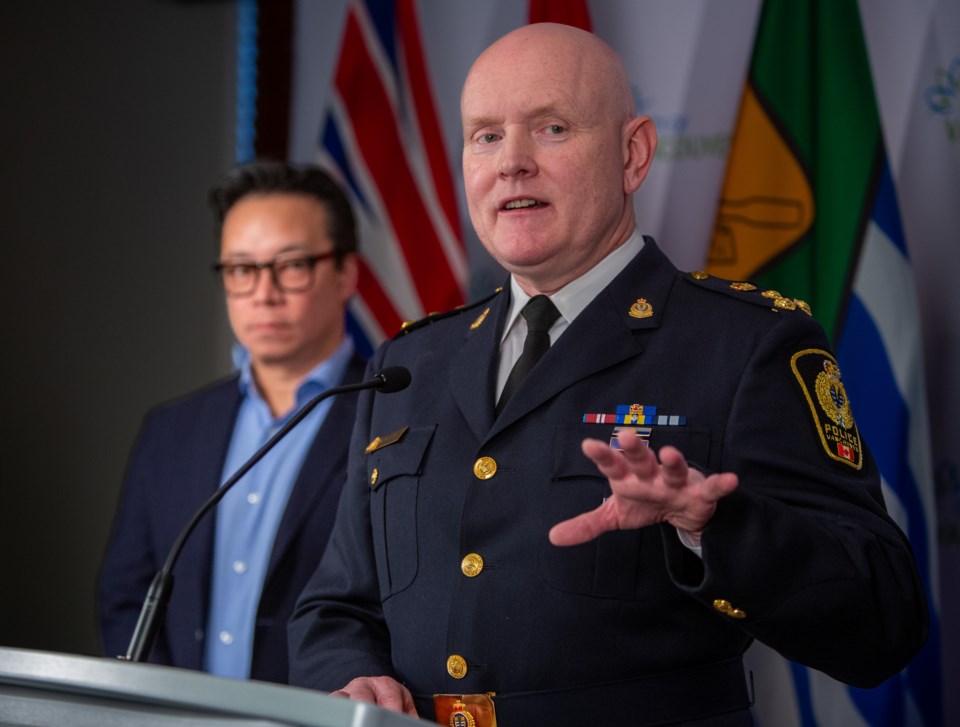Vancouver Mayor Ken Sim and Police Chief Adam Palmer announced a $5-million strategy Thursday to dismantle organized crime networks and target criminals in the Downtown Eastside.
Dubbed “Task Force Barrage,” the strategy aims to enhance and add to police efforts already underway in the Downtown Eastside, an area which Palmer said accounts for more than 30 per cent of violent crime in the city.
“The primary function will be to target chronic offenders, to arrest people with outstanding warrants and people breaching their bail conditions, to drive out drug traffickers linked to street violence and organized crime who prey on those vulnerable members of our community," the chief told reporters at a city hall news conference.
“They will also deter crime by maintaining a highly visible presence in the neighbourhood, and will respond immediately to protect victims and apprehend offenders when crimes occur.”
Palmer said the strategy will involve more uniformed officers on the beat to reduce street crime and violence, additional “complex and coordinated investigations” to target gangs and organized crime groups, and “improve community partnerships to address social needs and improve community safety.”
The chief acknowledged that previous police chiefs and mayors have announced various strategies and projects to reduce crime and street disorder in the Downtown Eastside. But Palmer said the timing of this strategy comes as the department is more aligned than it has ever been with the city’s current administration.
“This has not always been the case,” he said. “I've been around a long time, and I will say that things ebb and flow with different levels of coordination and cooperation between the city and the police department, and we're probably the best I've ever seen it.”
Chinatown, Strathcona, Gastown
That relationship has included the recent creation of what the chief described as integrated response teams. The teams include bylaw officers, city engineering crews, the fire department, police officers and sanitation workers.
That team’s role is to address illegal activity, encampments, structures, garbage, street flushing and general cleanliness of the neighbourhood.
Over the years, community organizers in the Downtown Eastside have shown evidence that previous high-profile strategies led by police or the city in the neighbourhood have pushed drug activity and street disorder to Chinatown, Strathcona and Gastown.
“We're going to be doing real time intelligence and analysis and making sure that we're addressing those issues so that other neighbourhoods, if they are impacted, we're going to get on it right away and ensure the safety of those neighbourhoods,” the chief said.
Reporters did not get an answer on how “long term” the strategy will be, or how long the $5 million will last. But the chief said the money “will get us a long way.”
“We're going to assess as we go, and we're going to keep up that sustained pressure,” Palmer said. “And if it requires more funding, then we'll talk to council, and we'll work through it.”
$50 million a year
For context, the VPD spent more than $2 million in overtime in 2024 for officers to escort city crews who continue to clear the sidewalks along East Hastings Street to ensure it doesn’t become an encampment again.
Sim told reporters that the City of Vancouver spends $50 million a year on various services on the small four-square-kilometre area that is the Downtown Eastside. Another $6.5 million is spent by the city on various mental health teams working across the city.
That $50 million does not include policing costs.
“We're at a breaking point, and we can't keep pouring money into a system that isn't delivering real results and keeps our most vulnerable individuals stuck in a cycle of poverty, addiction and crime,” the mayor said.
Sim said homeless people and those in “deep poverty” are 19 times more likely to be victims of crime. Those with mental health and substance use disorders are 23 times more likely to be victims of crime, he added.
“This isn't just about public safety,” the mayor said. “This is a humanitarian crisis, and the situation in the Downtown Eastside has reached a tipping point. Today, we take the first step towards ending the cycle of violence.”




